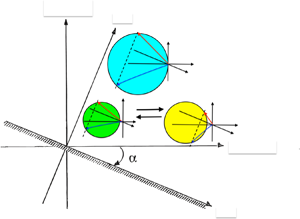Published online by Cambridge University Press: 14 May 2021

We study the possibility of having resonant interactions between three Rossby modes on a coast or channel of arbitrary orientation. A Rossby mode comprises two propagating Rossby waves (RWs) to satisfy the no normal flow through the boundary(ies). In each geometry, we state the conditions, degrees of freedom and RWs of the primary two modes that could force a third mode. We discuss differences between zonal and non-zonal orientations. Resonant interactions are only possible if all RWs participate in the zonal case, while only three RWs participate in the non-zonal case. The non-zonality reduces the degrees of freedom of the resonance conditions, and the solutions are more restrictive for more meridional orientations. In particular, there are no solutions if the coast or channel is meridional. For the non-zonal coast, we find a family of solutions for given periods  $T_1$ and
$T_1$ and  $T_2$ of the primary modes. Using multiple scales, we obtain a uniformly valid solution of the quasi-geostrophic potential vorticity equation (QGPVE), with the resonant modes exchanging energy in space. There are no degrees of freedom for the non-zonal channel, and we develop a graphical method to seek resonant solutions, finding some. We provide a bounded solution of the QGPVE in case the primary modes excite one RW, not a channel mode, and the modes do not exchange energy either in time or space. Regarding possible oceanographic applications, we show solutions for the Hawaiian Ridge and inquire if there are solutions in the Mozambique Channel, Tasman Sea, Denmark Strait and the English Channel.
$T_2$ of the primary modes. Using multiple scales, we obtain a uniformly valid solution of the quasi-geostrophic potential vorticity equation (QGPVE), with the resonant modes exchanging energy in space. There are no degrees of freedom for the non-zonal channel, and we develop a graphical method to seek resonant solutions, finding some. We provide a bounded solution of the QGPVE in case the primary modes excite one RW, not a channel mode, and the modes do not exchange energy either in time or space. Regarding possible oceanographic applications, we show solutions for the Hawaiian Ridge and inquire if there are solutions in the Mozambique Channel, Tasman Sea, Denmark Strait and the English Channel.